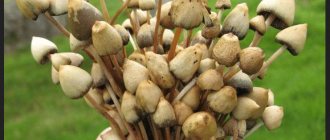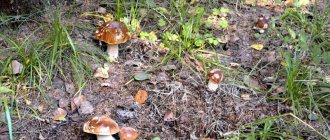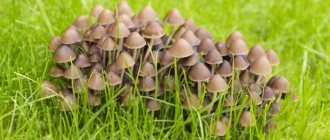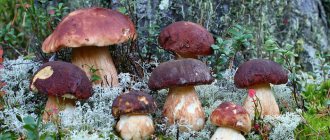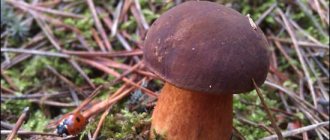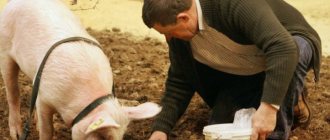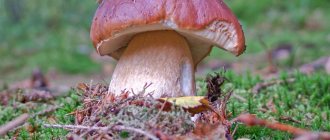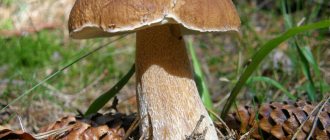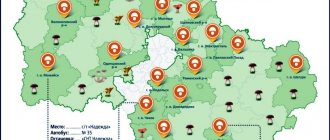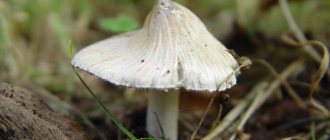Types and areas of growth
There are a lot of similar mushrooms with psychoactive effects in the world and they grow in different parts of the world.
The most potent are those illegally exported from India, Indonesia, South America and Mexico. In Russia there are about 500 species of hallucinogenic mushrooms. These fungi are absolute saprophytes, that is, they feed on organic remains. They love to settle close to people, in semi-inhabited places. They occupy places where the natural balance is already disturbed (fields, livestock grazing, mowing meadows) and there is a large amount of cow or horse manure. In the complete wilderness there are practically none of them.
The following mushroom genera contain psilocin:
- paneolus;
- Gymnopil (14 species with poisons that affect the psyche);
- fiber (4 types of these mushrooms out of 5 containing a hallucinogen are deadly poisonous);
- psilocybe (150 species have been described, more than 115 contain narcotic substances).
The most poisonous part is the leg. The cap contains less active substance.
Most species are simply unpleasant to taste; the percentage of toxic substances in them is small. Some varieties can cause severe hallucinations, but do not lead to death.
Psilocybe semilanceata is well known among the people and even has appropriate “funny” names: prushka, merry, cap of liberty, sharp conical bald head. Grows in India, Australia, South America. On the territory of Russia it can be found in the Moscow region and in other territories with a similar climate.
The active ingredient is psilocybin. Contained in both dried and fresh mushrooms. People who use drugs compare the effect of the mushroom with LSD, only a little softer.
Psilocybe semilanceata is prohibited for circulation on the territory of the Russian Federation. It is precisely the spread of these toadstools that law enforcement agencies are actively fighting against.
Outwardly it looks like a small mushroom on a thin stalk with a sharp conical cap. Height - up to 3 centimeters. Color - brown with an olive tint. Prefers to occupy fields, rarely visited meadows, and wet places. They can even be found on grassy sports fields.
It grows especially actively in the fall, when the air temperature drops to 5 degrees Celsius, but can also occur in the summer.
Stropharia shit
This is a small mushroom on a thin stalk, which people call in an extremely unappetizing way - poop bald spot. The cap is quite large, shiny, brown, round in shape, with small uneven scales along the edges. Color - from light to dark brown.
It prefers manure heaps as a substrate, where stropharia can be observed individually or in groups. The most active growth is from mid-August until cold weather. Distributed in Mexico and the USA. It is extremely rare in Russian latitudes.
Stropharia has become popular due to the psilocybin it contains. Previously, ritual potions were made from it.
An unusually beautiful small mushroom, bluish-green in color. Externally they resemble a champignon. It prefers to settle on tree stumps, in grass, sometimes even in horse or cow dung. Found in Europe and North America.
There is a related, more beautiful view. It's called sky blue stropharia. It grows along roads, in grass and even on lawns. But it is very rare.
Troischling is not poisonous. But they don’t use it for food because it is absolutely tasteless (it looks like a radish). Even if it accidentally gets into the cauldron, it is impossible to get poisoned by it.
There is still debate about its hallucinogenic properties. They exist, but they are very small, since the dose of psilocybin there is absolutely insignificant.
Paneolus campanulata (bell asshole) is a ubiquitous small mushroom that grows in colonies. It is also called bell-shaped dung beetle or moth beetle. Grows on well-fertilized soils or simply on manure from April to December. In Russia you can find them near cowsheds, chicken coops and stables.
Outwardly, an absolutely inconspicuous mushroom: on a thin stalk with a bell-shaped cap, very fragile. It stands out among other dung beetles for its regular shape. Color - grayish-brown, sometimes whitish. Height - up to 8 cm. Active ingredient - psilocybin.
Hay beetle
These magic mushrooms are ubiquitous. Can be found in pastures, river valleys and even in flower beds. A small mushroom with a light brown cap with a dark edging. In young specimens it is yellow or cinnamon-colored. They grow in small groups from spring to early December.
The body of the dung beetle contains quite a lot of psilocybin, the activity is medium. It was noted that once ingested, the effect of the substance can begin within 20 minutes, especially if the person was hungry. The effect is similar to the drug LSD. But in case of accidental ingestion, poisoning is not considered severe.
Leopard mushroom
There are two types of mushrooms called leopard mushrooms, both of which are dangerous when consumed. They prefer the temperate climate of the Northern Hemisphere.
Psilocybin mushrooms
Psilocybin mushroom (or, as people say, hallucinogenic mushroom) has been known to mankind since ancient times, before the beginning of our era. At one time, without really understanding medicine, ancient healers used this mushroom to “see the future” and speak with the Gods. We know that psilocybin mushrooms are no less dangerous than LSD. It is also worth noting that in Russia, law enforcement agencies are actively fighting the spread of the “natural drug” and punishing people who grow or use psilocybin.
Use
These mushrooms are inedible, and some are also very poisonous. Drug addicts try to use toadstools to get a dose of pleasure.
Psychedelics are eaten raw, dried, and special decoctions are prepared.
Many people do not know or forget that these mushroom bodies contain the poison myocin, which causes serious harm to health. People with a diseased liver begin to feel this especially quickly. They immediately have pain in the right side.
Dosage
There are no medical indications for using hallucinogens. They are hunted for extreme sensations, coming into conflict with the law.
The effects of using a psychedelic are directly dependent on the dose taken.
There is even a scale by Carl Graham, who derived a dependence called “from 0 to 5”:
- At the first level, there is an increase in the acuity of perception of music and color.
- At the second stage, partial memory loss begins.
- At the last stage, there is already a loss of contact with the surrounding reality and orientation in space.
In general, everything is very individual. It is approximately calculated that for a person weighing 80 kg, a dosage of 3.2 kilograms of dried mushrooms is fatal. However, practice shows that some people are more sensitive to these drugs, while others may not feel anything at the same dose.
If the mushroom is consumed on an empty stomach, then you can feel the effect of toxins within twenty minutes. The person is under the influence of the hallucinogen for approximately 7 hours. It takes about two hours to recover from this state.
A dose of up to 20 mushrooms is considered practically safe.
But poisoning can be determined even after a few days. Even no longer seeing the desired glitches, the victim remains inhibited and is not entirely aware of his actions. Addicts describe this state as “being in a fog.”
Dosage
In the circles of “mushroom addicts” it is believed that to achieve a normal effect you need to consume about 30 g of fresh or 50-60 g of dry fruiting bodies.
It all depends on the type and amount of psilocybin in its composition. For example, mushrooms grown in Karelia will have a stronger effect on the central nervous system than the same varieties from Moscow or St. Petersburg.
Sensitivity to psilocybin is proportional to body weight. The more a person weighs, the more active substance he needs to achieve a normal psychotropic effect.
The effect of Psilocybe semilanceolata on the human body
Accidental entry of dangerous forest inhabitants into food products leads to poisoning. The action differs in the speed at which the reaction begins. On average, deterioration will occur within 20 minutes. But there are other periods of time:
- mushroom broth - after 10 minutes;
- some mushroom dishes – 45 minutes.
What happens to a person:
- partial loss of mind;
- complete shutdown of rationality;
- stage of madness;
Getting out of this state is not always possible on your own. In most cases, only doctors can bring the patient back to reality. Residual effects will be observed for several more days. Experts call this period of time the afterglow. It is characterized by the following indicators of health and general condition:
- pacification;
- detachment;
- slowness of reaction;
- depression;
- increased perception of the environment.
Sometimes doctors state conditions that are opposite to calm: a person becomes nervous, he begins to look for the meaning of life, suffer and worry.
When mushrooms enter the intestines, psilocin is absorbed into the blood. At first, a person experiences a feeling of euphoria. This occurs due to the effect on the receptors that produce serotonin. This is the name of the hormone of joy.
A person who has come under such influence experiences pleasant emotions. He sees unreal visual images. Suddenly all the senses become heightened. Objects become brightly colored. Incredible moving bright images or “cartoons” appear before your eyes.
The patient is in the initial stages of drug intoxication.
Symptoms of poisoning
An outside observer begins to notice the strange behavior of the mushroom victim while the latter is having a bout of euphoria.
People around see a completely different picture, not so rosy:
- tremor of the limbs;
- unsteady gait;
- impaired balance and coordination of movements;
- chills and fever;
- tachycardia;
- picture of gastrointestinal disorder;
- sudden mental disorder;
- alternating attacks of causeless laughter, anxiety and horror.
In severe cases, the patient may become aggressive or have suicidal ideas.
Consequences
Most often, victims are brought out of this state. Mushrooms are not as instantly addictive as hard drugs. However, such cases are known.
Regular use of illicit substances can lead to acute psychosis. There have been cases where mental problems began to appear after some time.
If the dose is exceeded and medical assistance is not provided on time, the patient goes into a coma. And then the person may die from acute cardiovascular failure.
The worst thing is if such mushrooms enter the child’s body. Not only does he begin to experience a mental disorder, but he also has a clear picture of food poisoning. Children experience abdominal pain, vomiting, diarrhea, and dizziness. Sometimes this can result in coma and death.
Benefits and harms
There are no benefits from using psychedelics. However, a single accidental use does not lead to serious consequences. It’s worse if people begin to abuse these dubious “gifts of nature” on an ongoing basis.
Toxic mushrooms affect the central nervous system due to the tryptamine surfactant group they contain. When they enter the brain, they not only help you see unusual pictures, but also cause severe damage.
While “high,” a person’s creation changes greatly. Negative changes in personality begin. Overdose threatens acute psychosis. In severe cases, it can result in serious psychological problems, severe long-term depression or insanity.
Psychoactive effect
As mentioned above, Psilocybe semilanceata became famous due to its rather high (up to 2.3%) content of the alkaloid psilocybin, which has hallucinogenic properties. Psilocybin is similar to serotonin and has similar effects to LSD. When taking semilacent, after about 20 minutes a transition period begins: the pulse quickens, the pupils dilate, a cold feeling is felt in the stomach, it becomes difficult to breathe, hands tremble, and vision deteriorates. Then the drug trip unfolds completely: the visual perception of the environment changes, hallucinations and delusional visions appear. The mechanism of psilocybin's effects on humans is not fully understood.
The state of a person who has taken psilocybin depends greatly on personality, health and mood: it can range from euphoric and carefree to terribly depressing.
The effect of the substance lasts from 4 to 7 hours. Typically, consumption of mushrooms and intoxication with psilocybin does not cause any consequences, since the toxicity of semilacenta is quite small. Exceptions include extremely large doses and long-term use.
The lethal dose for humans when consumed is about 15 grams of pure psilocybin. Danger can come from poisonous mushrooms that, due to inattention and inexperience, are mistaken for psilocybe. In addition to psilocybin, the mushroom cap contains psilocin, baeocystin and norbaeocystin and is the most popular and powerful psychoactive mushroom in the world.
Among the vast diversity of the fungal kingdom, Psilocybe semilanceolata has found its use in humans as a psychedelic drug and has its own history. Since ancient times, rock paintings of magic mushrooms have reached us.
The Aztecs are known to have used psilocybin mushrooms for their rituals.
The first case of intoxication was described back in 1799 in London. The species Psilocybe was first identified by James Sourby in his book Colored Illustrations of English Mushrooms in 1803. In the sixties of the twentieth century, chemist Albert Hoffman, who first synthesized LSD, carried out a chemical analysis of the body of the mushroom, and revealed the content of the psychoactive substance.
What does the psilocybe semilanceolate mushroom look like?
Psilocybe semilanceata (seven cents) is part of the poisonous group. The mushroom is dangerous due to its psychic-activating effects. A person will begin to experience health-threatening symptoms an hour after toxic substances enter the body. Outwardly, like most of its poisonous counterparts, it does not look attractive.
- The usual color of the cap is olive;
- other possible tones are beige, brown, gray;
- head shape - cone;
- the edges of the upper part are covered with grooves;
- the center of the cap is a small blunt tubercle (papillary);
- the skin is removed;
- the skin is soft, slippery and sticky to the touch.
Gradually, the cap changes, from a conical formation at the moment of full maturation it becomes similar to a bell, then during the aging period it begins to level out and becomes flat.
The mushroom grows up to 12 cm. The thin stem bends due to the hollow interior. It can be pure bright white, dirty gray or yellowish. You can see scaly formations near the mycelium.
Similar mushrooms
There are several species that look almost like psilocybe, some are very toxic. It is very important to know what psilocybin mushrooms look like, notice the differences and be extremely careful!
- The beautiful cobweb is distinguished by its red-brown color and large size, and contains a dangerous poison that causes irreversible changes in the human kidneys.
- The earthen fiber is distinguished by its white-pink color and cap structure, and contains the dangerous alkaloid muscarine.
- Psilocybe erectopods does not have a tubercle at the top of its cap.
- The hay dung beetle can be identified by the structure of the stalk and the absence of a characteristic tubercle.
Application for personal growth
Psychedelics have found their place in medicine and pharmacology. Research is being conducted that should allow them to be used to improve the quality of life of patients suffering from incurable diseases. It is likely that hallucinogens can alleviate their condition.
An important role here is played by the fact that patients do not develop dependence. This means that it is possible to use psilocybin in other cases.
In modern medicine, in hospitals, narcotic substances are used to relieve excruciating pain in certain types of diseases that are not fatal, but have severe symptoms. Patients have to go through not the most pleasant moments, because doctors are afraid of addiction and lengthen the pause between drug administration. In Russian medical institutions this is called “administration on demand” and is done at those moments when the patient’s patience is running out.
It is likely that experiments with psychedelics in the future will effectively and quickly remove pain symptoms from the patient. And it will not turn a recovering person into a drug addict.
There is an opinion that psilocybin helps with cluster headaches. These are spontaneously occurring sharp and painful spasms in the brain.
Scientists from the USA even conducted small studies. It has become known that part of the population illegally regularly uses small doses of psilocybin to relieve cluster pain. But these scientific studies cannot be called objective, since they were conducted in the form of a survey of a group of young people from wealthy sections of society who regularly use illicit substances in small doses to treat headaches. Experts do not deny the possibility that in a laboratory under supervision and with regular examinations there would have been different results.
Against drug addiction
Psilocybin mushrooms are classified as illegal drugs. Although studies have shown that they cause less harm than other common and more popular remedies. They are less effective and practically do not lead to psychological dependence. Because of this, the popularity is less, since there is no possibility of forming a permanent customer base for dealers.
Long-term use leads to schizophrenic disorders and schizophrenia.
These fruiting bodies are not used in the treatment and rehabilitation of drug addicts, as they contain poisons. The effectiveness of artificially synthesized psilocybin in such cases has not yet been proven.
Research has shown that these substances are not suitable for treating people with mental disorders. Psilocybin, on the contrary, worsens symptoms. Patients suffering from schizophrenia may experience exacerbations.
There is already evidence that people who have been addicted to mushroom-derived psychedelics in the past may suffer from severe panic attacks after a few years. Apparently, plants contain substances that have some kind of delayed effect on the psyche, but this issue has not yet been sufficiently studied.
In the modern world, these prohibited substances are actively promoted on specialized websites. It is actively suggested that psilocybin enhances autobiographical memories and helps to resurrect images of the past. Allegedly, this is why it can be used during meditation in personal growth courses. These actions are illegal, but this does not stop businessmen chasing profit.
Promoters of such an “experience” offer to “feel the world through the eyes of a child.” It is also recommended to take this drug to treat depression, contrary to all doctor’s recommendations. Course organizers and sellers of prohibited plants carefully keep silent about serious side effects.
People who have tried these practices are categorically advised against even touching mushrooms, especially when in a bad mood. There is a sharp deterioration in both physical and psychological condition.
Most of the hospitalized patients affected by the ingestion of “magic” mushroom bodies experienced panic attacks. At this time, people became disoriented, confused, agitated and anxious.
The substance contained in mushrooms cannot be isolated in a home laboratory. That is why doctors warn that such experiments can kill a person. But the impact must be constant, that is, a person must systematically destroy his body. Western pharmaceutical production uses the substance to treat various pathologies. Used as a neurotropic drug. It is included in a complex of drugs against:
- memory impairment;
- increased anxiety;
- paranoia;
- schizophrenia;
- migraine.
Any drug must be prescribed by a doctor. You shouldn’t start cooking with poisonous mushrooms yourself; you can cause dangerous complications and unforeseen reactions of the body.
Mushrooms in Russia
It is difficult to find a place where these mushrooms are not found. They take root everywhere, even where there is no nature. The only requirement is the presence of organic matter. Because of this, pastures and other fertilized areas are a favorite location for psilocybin fruiting bodies. To put it simply, these are social specimens that mostly live near humans.
In Russia there are only a few varieties of psilocybin:
- Psilocybe lanceolate. Has a disgusting appearance. Distribution zone: Leningrad region and Far Eastern region. Shows peak activity from August to October.
- P. Subbalteatus, also known as Paneolus fringe. Distributed throughout Eurasia, including the Moscow region and Siberia.
How to identify a mushroom and distinguish it from similar species
When going to the forest, mushroom pickers prepare. But more often this preparation includes the appearance of a mushroom picker. Experienced foresters advise not to forget about theoretical training and knowledge. This approach will avoid mistakes. Inedible and dangerous inhabitants of the forest will remain untouched and will never appear in the basket. What distinguishes the poisonous guest of the forests, the psilocybin species:
- the hat is thin and ugly;
- the interior is lamellar;
- the surface of the head varies depending on the place of growth: dry, wet.
- the plates are firmly connected to the leg, almost united;
- spores are similar in shape to grains;
- The structure of the leg is cartilaginous.
Description of mushrooms
Psilocybin mushrooms look very characteristic.
On a thin hollow fibrous stalk, 4 to 10 centimeters long and 0.2 to 0.3 centimeters wide, there is a small cap with a diameter of 0.5 to 2 centimeters. The conical or dome-shaped cap at the top in the center has a small sharp or rounded elevation, by which a psilocybin mushroom can be identified.
The edges may be curled inwards and the color varies from olive brown in wet weather to light straw in dry weather. The skin is covered with mucus, smooth, and easily peels off in young mushrooms.
The leg is wavy curved, but can also be straight, the same color as the cap, closer to the base with a blue tint. In places of damage, the body of the fungus turns blue. The plates are initially light and then darken to a violet hue. The pulp is light with a slight smell of grass or mold and a slight unpleasant taste.
Mushroom picker addicts are born in the Moscow region
- Well, why did these damn mushrooms grow in our area? — The fighters of the anti-drug trafficking department of the Ramensky Department of Internal Affairs do not hide their dissatisfaction. You will be happy here! There is already enough serious work: heroin, dots, gypsies, Tajiks. So the “pioneers” with their eyes wild with toadstools fell on the heads of seven operatives. The valiant traffic police officers “helped” their colleagues. How they learned that mushrooms of the Psilocybe pelicullosa family cannot be collected is unknown, but it was they who brought the first “mushroom picker,” along with trophies on thin legs, to the local ONON in early September. I got caught by a drug addict by accident. The inspectors looked into the trunk, and there was a heavy bag of gray mushrooms. It was then that it turned out that nature had blessed the local policemen with a huge field that had not been plowed for ten years. And instead of some useful turnip in the national economy, shaman’s toadstools grew on it. Now, investigators spend several days a week in nature, catching hallucinators in the tall grass. There are already thirteen souls of these. Whoever eats on the field does not count. We don’t punish you for ingesting this nasty stuff. — Are you also drawn to the fields? — the guys from the department grin. - Okay, let's go. Take our walkie-talkie and stay low. And the field is really big. Eight human figures are barely visible in the tall grass, either disappearing or emerging from the thickets like floats. - Don't go into the field. You will scare off clients. Let's go to the station, the guys will report on those who have already filled their pockets. What you definitely won’t see in the hands of the “toadstools” are baskets and baskets. They go hunting in the forest either with plastic bags or with empty cigarette packs. The mushrooms themselves are tiny, so even in a pack you can fill two “doses” of about forty of them. “Attention, wait for three people,” we hear a signal from the “ambush” on the radio. The first fighters from the local UNON department detained three teenagers from the capital. Frightened faces, childish blush on the cheeks. The boys went to pick mushrooms after school. Someone I knew explained how to get there and even provided me with photographs of mushrooms downloaded from the Internet. Young people, they haven’t seen the Indian horror film “The Mushroom Man”, which shocked us in childhood, so they put all sorts of nasty things into their mouths. — Fresh air, nature. - one of them drones non-stop, like DJ Groove. “These smart ones, they ate it right on the field and decided not to take it with them.” Greed or hunger - maybe they didn’t have breakfast in the morning - saved the guys from criminal charges. - Do you already feel something? “Not before that,” the boys explain gloomily. It turns out that the effect of mushrooms, or rather, the drug psilocybin they contain, depends on the mood of the eater. “You need to think about good, joyful things, and then the glitches will be funny and colorful,” the guys explain to us. - And if about the bad. You can imagine what they might see on the train after a short constructive conversation with the police. After an educational conversation with the “pioneers,” the arrest of the next aggressive mushroom picker takes place like in an action movie. A knife knocked out of his hand, his arms twisted, handcuffs behind his back. - We need to collect mushrooms! — accompanying the client to the car, we pass by old acquaintances waiting for the train with a stomach full of toadstool. One of the operatives shows them a heavy bag of forest gifts. - Gosha! — Dozens of gray mushrooms are reflected in the clouded eyes of the boys. This “wow” will lead to serious investigation and trial. Despite the outward innocence of the gray fungus, those who have collected more than half a gram of dried mushrooms face criminal charges. And if the experts, having weighed the dry pile, determine that it weighed fifty grams or more, then the collector will be charged with “storage of drugs in especially large quantities.” For example, like a 24-year-old builder from Moscow, sad by the car in handcuffs. According to him, he collected mushrooms not for sale, but to make playing on the computer more fun. “By eye” there are three hundred grams in his package, sit at the computer for a month without interruption. “Surprisingly, during all the time we were catching mushroom pickers, we didn’t come across a single local,” the opera says. — Only Muscovites, mostly students and schoolchildren. Criminal cases have already been opened against everyone who was caught red-handed. But what punishment the mushroom pickers will receive is not yet clear. The Ramensky court has never had a hearing on the collection of hallucinogenic toadstools.
Hallucinogenic mushrooms in the Moscow region
PlurMusic Vibe ﮌ pinned post
REMINDER FOR A BEGINNING MUSHROOK PICKER You can’t just find a psychoactive mushroom. The left person will never guess about it, because it is a cunning mushroom, it hides from people. Psilocybin mushrooms grow in open spaces, fields, lawns, forest edges, and clearings. If you just look from above, they are not visible, because they are hidden in the grass.
The favorite habitat of psychoactive mushrooms is perennial hummocks and grasses. To collect these mushrooms, you have to crawl among the hummocks, pushing them apart with your hands, otherwise you won’t notice them. Experience and instinct come with time. Time after time, as you become more familiar with the mushroom, you begin to feel where it can hide, and where it is useless to look for it. Field to field is different. It is never found in cultivated fields. Even if the field is fallow, the mycelium in such a field does not have time to develop to such an extent as to bear fruit. P. semilanceata is always symbiotic with certain species of grasses of the grass family. It happens that in the same field there is an area where homogeneous “common grass” grows, there, in the hummocks, you find mushrooms, but if you move further away, where other plants, clover, dandelions begin, it is useless to look there. When is the best time to look for psilocybin mushrooms?
The mushroom meadow may be slightly flooded, or periodically flooded after rains. But! In this case, the soil must be airy, loose, and peat-like. And psilocybin mushrooms in such clearings usually grow not just anywhere, but in tufts of grass on hummocks.
Beware of false toadstools - they cause pseudohallucinosis (and, as a consequence, quasi-schizophrenia with general emotional integrity). Psilocybe Semilanceata mushroom does not grow on tree stumps!
It is best to look for psychotropic mushrooms the next day or the day after good rains. The heavier the rains, the greater the likelihood that hallucinogenic mushrooms have been trampled. Cold weather also provokes their appearance. After a week of dry and warm weather, even at the height of the season, even in the best clearings you will most likely not find anything. It is best to look for new deposits of psychoactive mushrooms in September-October-November. They also appear in mid-August, but this is not a very good time to search for new mushroom glades.
Consumption of hallucinogenic mushrooms Psilocybe The optimal average dosage is 25...30 medium hallucinogenic mushrooms. A dose of 50 or more mushrooms is considered high. In general, doses of psilocybin mushrooms are individual: from 7 pieces to infinity. There are no known deaths caused by the use of psilocybin mushrooms or synthetic psilocybin. Of those mushrooms that grow in similar conditions to Psilocybe Semilanceata and which can somehow be confused with them, not a single one is known to be poisonous. Contents of psilocybin and psilocin The effect of psychoactive mushrooms with an average dose of psilocybin of 6...10 mg usually begins after 30... 60 minutes. This is how long it takes for hallucinogenic substances to penetrate the blood through the stomach. Taking psychotropic mushrooms on an empty stomach not only speeds up the absorption of psilocybin, but also enhances the overall effect of the mushroom. Hallucinogenic mushrooms change your understanding of time and space; under mushrooms, everything is perceived more acutely than in a normal state. When consuming psychotropic mushrooms, you must always remember that: - under magic mushrooms, feelings are heightened, both positive and negative; — psychoactive mushrooms will not harm your health; - if you feel unwell, eat something light (a piece of bread, for example) and try to drink plenty of water or tea without sugar; - if you want to stop the trip, you can take 500...1000 mg of vitamin C or sugar (Cola, Sprite, Fanta); — do not take hallucinogenic mushrooms too often! Give yourself time to process your psychedelic experience; - use magic mushrooms only in a safe environment, or in the forest in good weather; - a joint after a trip will not cause any harm, but it can, like other psychedelics, cause flashbacks;
